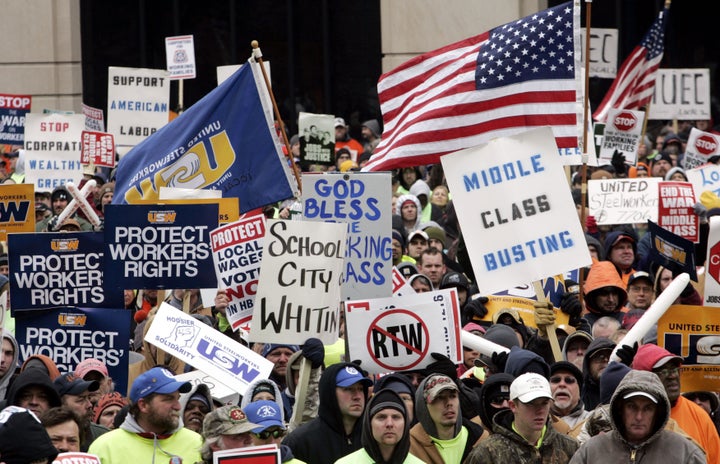
The labor movement's call for a Day of Solidarity on the April 4 anniversary of Martin Luther King Jr.'s assassination could not come at a more critical moment in history.
America needs a strong and innovative labor movement now more than ever. That is the lesson the country is taking away from events in states like Wisconsin where by a wide margin the public stood up and opposed attacks on public-employee rights to collective bargaining. These attacks come on the heels of more than 30 years of gradual decline in the ability of private‐sector workers to exercise their right to join a union and gain access to collective bargaining.
If American labor learns from and applies the lessons of Wisconsin, it could lay the foundation for a major resurgence that would benefit the current and the next generation of America's working families, put the country back on the road to shared prosperity and strengthen our democracy.
But if labor fails, or hunkers down after rebuffing the worst of these attacks, the slow decline in private‐sector unionism will be mirrored by a similar decline in the public sector that accelerates the race to the bottom for the American economy.
I see five actions essential for transforming and renewing American labor, all of which are highlighted in the Wisconsin struggles. Specifically, to turn this Day of Solidarity into a sustained transformational strategy, labor will need to:
1. Overcome prior internal differences and unify labor unions -- public,
private, AFL-CIO affiliated, and unaffiliated -- in standing firm against attacks on public‐sector worker rights.
The firefighters and police unions showed the way in Wisconsin by standing with their sister unions even though they were exempted from the governor's attacks. The vivid and powerful image of firefighters standing in solidarity in their first‐responder gear on the steps of the capitol and the leadership provided by the president of the state firefighters were worth more than a thousand words.
2. Build a broad-based coalition with the public and with other progressive groups to stand with labor against attacks in support of basic worker rights.
National polls showed Americans opposed the Wisconsin governor's attacks on collective bargaining by a 2 to 1 margin. Groups as diverse as the Catholic bishops to the Association of School Superintendents to the Green Bay Packers spoke out against taking away bargaining rights. A new broad coalition, "We are Wisconsin" continues the fight.
3. Demonstrate that collective bargaining, properly structured and
conducted in a modern, problem-solving way, is part of the solution, not part of the problem. Follow through with a positive, transparent approach to education reform and other fiscal challenges and public-service improvements.
A large number of Wisconsin school districts extended their bargaining agreements to avoid the new law. This provides unions and school officials in these districts a two‐year window to demonstrate that more educational innovation and improvement can be achieved by working together collaboratively than in those districts that try to force change through topdown unilateral actions. The results of this horserace will not only determine the outcomes of the next statewide elections. Given Wisconsin's pivotal position in national politics, it could quite possibly determine who will be the next president.
4. Hold together the broad‐based coalition that supported public‐sector
unions in their time of crisis and welcome all these individuals and/or groups into the labor family.
Create honorary or newly conceived associate, lifetime memberships in an extended labor network, one that is led and sustained by young people using the same the modern social networking technologies they used to mobilize during the crisis. Young people supported labor in this crisis more than any other group. Now is the time to give them the opportunity to put these tools to work in building and leading the next‐generation labor movement.
5. Use this broader social network to build a broad‐based political force that brings a progressive voice into national, state and local affairs. Put issues of great concern to all citizens and especially to young families, such as sustainability, family care and education at the top of labor's agenda. Embed reform and modernization of private-sector labor and employment policies in this broader agenda.
For a quarter century labor has failed in efforts to enact needed labor-law reforms to protect private-sector worker rights to organize. The same broad coalition that has sustained Wisconsin's public‐sector workers stands ready to work shoulder‐to‐shoulder with private-sector workers if labor takes up its priority issues with as much gusto and skill as it did in the cause in Wisconsin.
If labor builds on these lessons, the 100,000 people who took to the streets of Madison and the numbers who gather for this Day of Solidarity could turn into millions of permanent allies, members, and leaders of the next generation labor movement. America's working families, economy and democracy would be the ultimate winners of this transformational moment.